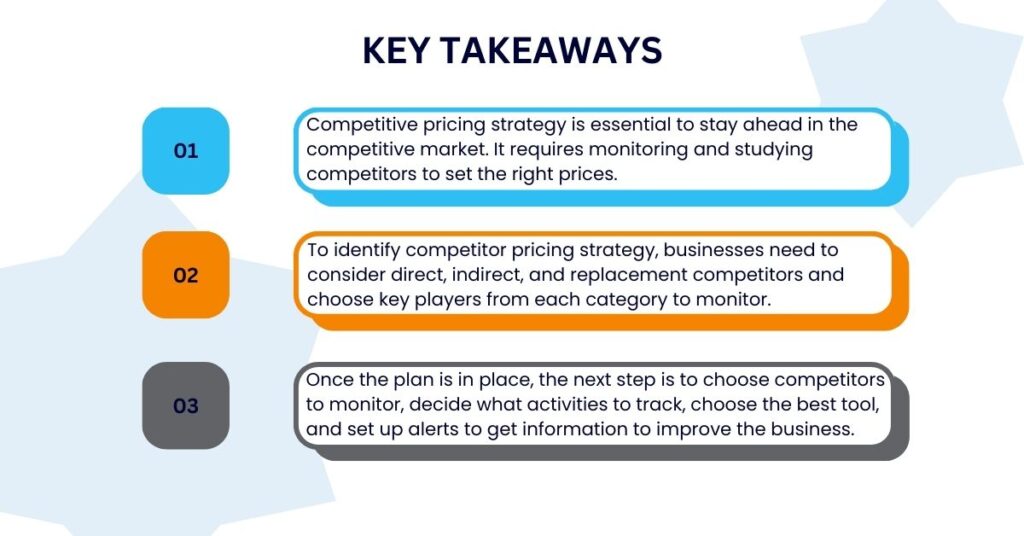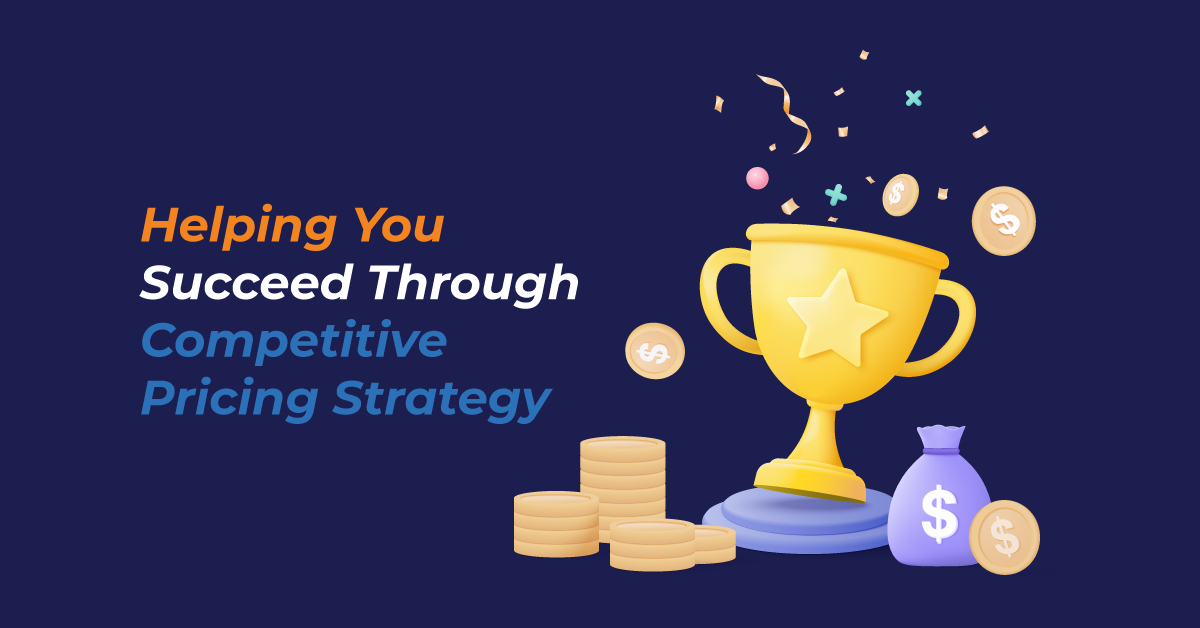In this competitive era, it is important to analyze and study the competitors to stay ahead. The key is to nail your business strategy by setting the right prices. It can benefit significantly to keep an eye on the competitors in the market. Competitor prices can help in developing your pricing strategy. There’s a lot that needs to be studied such as your competitor’s social media strategy, their PR and promotional strategies, how they deal with customer issues, etc. Competitor monitoring is a broader term that encompasses several aspects and helps in creating an excellent competitive pricing strategy.
Competitor pricing intelligence helps in understanding whether your plan is sound or whether there is a need for some tweaks. It doesn’t take much to stay on top. The right strategies can come to your rescue. If you have a plan in place, competitor monitoring can become a cakewalk.
Key Steps to Identify Competitor Pricing Strategy
1. Figure Out the Key Competitor
Most businesses feel that they are aware of the competitive prices. However, they only consider direct competitors. For most companies, competitors are the ones that make what you make. For example, you make Coke and they make Pepsi, you make Nike and they make Adidas.
You should not only consider the direct competitors who are selling products that look like yours. You need to consider even those competitors that are chasing your market. Competitors can be categorized into three:
- Direct competitors are the brands which offer the same product as you do.
- Indirect competitors are the ones that sell different products but target the same need.
- Replacement competitors are the ones that compete for the same budget as your brand, even when the product is different.
For example, a lipstick brand can consider another lipstick brand as its direct competitor, a lip gloss/ lip balm brand as its indirect competitor, and an eyeliner/ eye shadow brand as its replacement competitors. For a comprehensive competitor pricing strategy, a business needs to keep an eye on what all these competitors do. The number of competitors you monitor depends on the resources. The list of competitors can be endless but you need to prioritize which competitors matter the most.
Make a list of the competitors consisting of direct, indirect, and replacement. Choose the key players from each category so you have a diverse range of brands to be monitored. Tracking competitor prices offers insight into your opponents and the broader industry.
2. Decide What You Want to Monitor
It is important to decide the kind of business information you are looking for. Tracking how much the competitor is spending on their office space is irrelevant. The information that can prove to be helpful is the competitor’s marketing goals and social media presence.
One of the best aspects of competitor monitoring is that it pulls in all of this data without having to search it. Track competitor prices to automatically collect a wide range of valuable data and information which includes the following:
a) The Marketing Campaigns
This is a top priority and competitor analysis offers information on when competitors launch new products and campaigns. If a competitor launches something innovative or exciting, you must know about it immediately. The analysis will also offer an insight on whether the campaigns were successful.
Monitoring tools provide the reach of a campaign and how many people are sharing the content on social media and forums. You will also get to track the response of the campaigns.
b) Social Media Presence
You must see where the competitors are most active and what does the social media consist of. It is essential to track the content and theme of their posts as well. Observe the images used and the tone of the message to see if they are working.
c) Content
The content means their website content and blogs. Keep a check on the website changes as your home page should be able to strike a great first impression. Focus on content marketing and go through their blogs. Competitor monitoring shows where and how the content is being shared.
3. Choose Right Tools
All the analysis should be done with the help of the right tools for collecting competitor prices as manual analysis is impractical. There is a lot to monitor and doing it without any help won’t help. There is a range of tools to choose from; something that can work and collect the desired data.
a) Web Tracking Tools
Web tracking shows where the competitors are being discussed in reviews, news, and forums. Media monitoring tools can help here. News and review websites can also prove to be helpful. When you come across any success story, ask where you lag.
b) Social Listening Tools
If your interest area is social media, a tool for that will help. Media monitoring tools cover social as well so both the goals can be achieved.
c) SEO Tools
Everyone needs a good SEO strategy to be in the top spot. It is important to track the keywords and backlinks they generate. There are several tools for monitoring the competitor’s SEO strategy. Identify what you want to see in the competitors and choose the matching tools.
4. Pull the Trigger
Now that you are clear about the competitive pricing strategy, it is time to get started. Once you have a plan in place, it is time to put everything into action. The first step is to choose the competitors that you wish to track/monitor. Decide what activities you wish to track and choose the best tool for the same. The next step is to set up the alerts for the competitors and see what comes back.
The idea is to look for information that will help in improving your own business. You can come up with an excellent strategy to beat the competition by tracking the competitor’s pricing strategies. For any business, monitoring competitor’s prices plays a crucial role as it helps in ensuring that your business is the best it can be. It is important for any business to be flexible to modify the strategy and adapt to the changing scenario as it is the key to success.

Benefits of Competitive Pricing Strategy
1. Laying the Ground Rules for Competition
Being in a competitive industry can make things a bit unnerving. Here, the first thing to do is identify your closest competitors and only focus on them. Or else the battle of unnecessary pricing wars will continue drying you of your resources without any kind of results.
Having WebDataGuru’s competitive pricing strategy by your side, you can create many opportunities for your business without losing the goals. You can track competitor prices and understand their strategies to create yours in a way that is beneficial for your business.
2. Gain a deeper insight into the market
By analyzing pricing trends in your industry, you can gain valuable insights into your market and adjust your pricing strategy accordingly. This can help you tailor your products or services to better meet the needs of your customers and stay ahead of changing market conditions.
The online market is ever changing and other giant eCommerce platforms like Amazon keep on changing their prices in order to cater to a larger audience who are price-sensitive. And competing with them or even being present on such platforms can be fruitful only if you go by certain tactics that work for your business.
3. Ensuring Customer Loyalty
Consumers are the key to growing more. So, getting their loyalty comes as the first priority once they become your consumers. And how can you do that? Understanding their choices and what motivates them to do a purchase and what puts them off. Consumer data can be received from honest feedback and getting their live opinions while using your products. This can help you understand the core to success.
Now, a competitive pricing intelligence platform can help you get better insights on buying behavior with precise data like which kind of products they surfed, what are the color preferences that get bought the most and the like. As an online retailer, this is like hitting gold!
Retail competitive pricing necessitates a comprehensive approach, integrating pricing intelligence, inventory management, and customer insights to continually refine pricing strategies and ensure a compelling value proposition.
4. Increased Profitability
After all that, you might now know the ultimate goal of profitability is a byproduct of all the above benefits and strategies. By tracking and monitoring competitive pricing, you can identify pricing gaps and adjust your prices as per competitive prices to increase profitability. This can help you maximize your profits and grow your business.
It’s Time to Upgrade Your Pricing Strategy
Competition can be daunting but if you know what you are doing and how you are going to approach the consumers then you are already miles ahead of your competition. WebDataGuru is one of the leading data extraction companies providing exclusive pricing solutions to all types of businesses. Monitor and ace the pricing game with a competitive pricing strategy.
So, if you want to drive sales, make better decisions, and get expert help, don’t hesitate to contact us today! Our team is ready to assist you.

Recent Comments